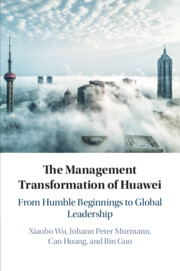Book contents
- The Management Transformation of Huawei
- The Management Transformation of Huawei
- Copyright page
- Contents
- Figures
- Tables
- Contributors
- Preface
- 1 The Management Transformation of Huawei
- 2 The Executive Management Team and Organizational Change
- 3 Transforming Product Development at Huawei
- 4 Huawei’s Transformation of Supply Chain Management
- 5 Financial Management Transformation in Huawei
- 6 The Transformation of Huawei’s HR System
- 7 Huawei’s Internationalization Journey
- 8 Huawei’s R&D Management Transformation
- 9 Huawei’s Intellectual Property Management Transformation
- 10 The Management Transformation of Huawei
- Book part
- Index
- References
9 - Huawei’s Intellectual Property Management Transformation
Published online by Cambridge University Press: 21 March 2020
- The Management Transformation of Huawei
- The Management Transformation of Huawei
- Copyright page
- Contents
- Figures
- Tables
- Contributors
- Preface
- 1 The Management Transformation of Huawei
- 2 The Executive Management Team and Organizational Change
- 3 Transforming Product Development at Huawei
- 4 Huawei’s Transformation of Supply Chain Management
- 5 Financial Management Transformation in Huawei
- 6 The Transformation of Huawei’s HR System
- 7 Huawei’s Internationalization Journey
- 8 Huawei’s R&D Management Transformation
- 9 Huawei’s Intellectual Property Management Transformation
- 10 The Management Transformation of Huawei
- Book part
- Index
- References
Summary
Huawei by 2014 had become the largest patent filer in the world even though it did not file any patents for the first eight years of its existence (1987–1994). This chapter examines the development of the firm’s intellectual property (IP) management capability. It describes important changes that Huawei undertook both in terms of its IP strategy (whether, when, where, and in what technical areas to patent) and the administration of its IP activities. Unlike the other major transformations that Huawei undertook with the help of Western consulting firms, Huawei could not make up its mind about how it was going to manage its IP strategy until a lawsuit filed in 2003 by a US competitor, Cisco, prompted top management to devote significant attention to this area. To support its internationalization strategy, Huawei subsequently implemented a systematic strategy to create a vast collection of independent intellectual property in telecommunication technology. Starting in 2003, Huawei embarked on a series of five-year plans, first to increase the amount of IP that would be generated by its large R&D efforts and later to increase the quality of its IP. To realize this strategy, large changes in the organization of the IP office had to be made. Huawei now employs over 400 full-time IP professionals to implement its IP strategies. Huawei offers lessons for other companies from emerging economies who want to compete successfully on the world market.
Keywords
- Type
- Chapter
- Information
- The Management Transformation of HuaweiFrom Humble Beginnings to Global Leadership, pp. 347 - 380Publisher: Cambridge University PressPrint publication year: 2020
References
- 1
- Cited by



